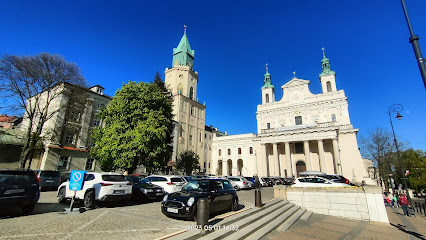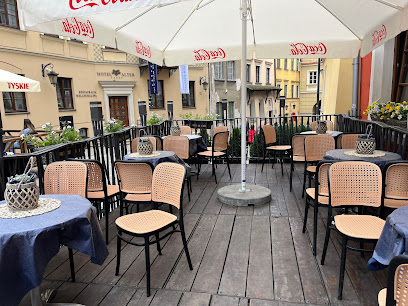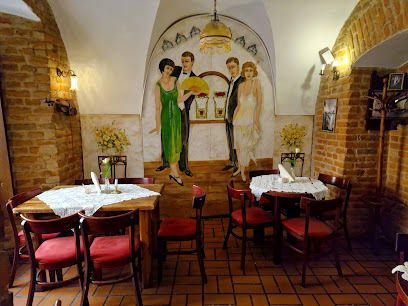
Stare Miasto: The Heart of Historic Lublin
Discover the charm of Lublin's Stare Miasto, where history, culture, and vibrant street life blend seamlessly in this picturesque Old Town.
Stare Miasto, or the Old Town of Lublin, is an enchanting maze of narrow cobblestone streets, colorful facades, and centuries-old architecture. As you stroll through this historic quarter, you'll feel as though you've stepped back in time. Each corner reveals a new facet of Lublin's rich past, from the medieval gate towers to the Renaissance-style buildings. The centerpiece of Stare Miasto is the picturesque Market Square, where you can relax at one of the many outdoor cafes, savoring traditional Polish dishes while people-watching. The square is surrounded by buildings with charmingly painted exteriors, each telling a story of the city's multifaceted history. Don’t miss the Crown Tribunal, a historic building that now serves as a cultural venue, hosting events and exhibitions. A visit to Stare Miasto wouldn’t be complete without exploring its numerous historic churches and museums. The Lublin Castle, perched on a hill overlooking the Old Town, offers stunning views and fascinating exhibits. For those intrigued by religious history, the Holy Trinity Chapel within the castle complex is adorned with unique Russo-Byzantine frescoes. As you wander, you'll also find hidden gems like the Grodzka Gate, a symbolic passage connecting different eras and communities. In the evening, Stare Miasto transforms into a lively hub of activity. The illuminated streets and squares are filled with the sounds of music and laughter, as both locals and tourists enjoy the vibrant nightlife. Whether you're dining at an upscale restaurant or grabbing a quick bite from a street vendor, the Old Town’s ambiance is sure to leave a lasting impression.
Local tips in Stare Miasto
- Wear comfortable shoes; the cobblestone streets can be uneven.
- Visit the Tourist Information Center in the Market Square for maps and local insights.
- Check the schedule for cultural events at the Crown Tribunal.
- Try traditional Polish dishes at one of the local restaurants.
- Take a guided tour to fully appreciate the historical significance of the area.
Stare Miasto: The Heart of Historic Lublin
Stare Miasto, or the Old Town of Lublin, is an enchanting maze of narrow cobblestone streets, colorful facades, and centuries-old architecture. As you stroll through this historic quarter, you'll feel as though you've stepped back in time. Each corner reveals a new facet of Lublin's rich past, from the medieval gate towers to the Renaissance-style buildings. The centerpiece of Stare Miasto is the picturesque Market Square, where you can relax at one of the many outdoor cafes, savoring traditional Polish dishes while people-watching. The square is surrounded by buildings with charmingly painted exteriors, each telling a story of the city's multifaceted history. Don’t miss the Crown Tribunal, a historic building that now serves as a cultural venue, hosting events and exhibitions. A visit to Stare Miasto wouldn’t be complete without exploring its numerous historic churches and museums. The Lublin Castle, perched on a hill overlooking the Old Town, offers stunning views and fascinating exhibits. For those intrigued by religious history, the Holy Trinity Chapel within the castle complex is adorned with unique Russo-Byzantine frescoes. As you wander, you'll also find hidden gems like the Grodzka Gate, a symbolic passage connecting different eras and communities. In the evening, Stare Miasto transforms into a lively hub of activity. The illuminated streets and squares are filled with the sounds of music and laughter, as both locals and tourists enjoy the vibrant nightlife. Whether you're dining at an upscale restaurant or grabbing a quick bite from a street vendor, the Old Town’s ambiance is sure to leave a lasting impression.
Iconic landmarks you can’t miss
plac Po Farze
Experience the vibrant culture and historical charm of Plac Po Farze, a must-visit square in the heart of Lublin, Poland.

The Old Town Market Square
Explore the beauty and history of The Old Town Market Square in Lublin, a captivating destination filled with culture, charm, and vibrant local life.

Plac Zamkowy w Lublinie
Discover the enchanting charm of Plac Zamkowy, Lublin's historical landmark, rich in culture, architecture, and vibrant local life.

plac Katedralny
Explore the historic heart of Lublin at Plac Katedralny, where stunning architecture meets vibrant local culture.

Remains of the Castle Tower
Discover the historical charm of Lublin at the Remains of the Castle Tower, a captivating site that showcases the city's rich heritage and stunning views.

Zabytkowa kamienica
Explore Lublin's rich architectural heritage at the Historic Tenement House, where history meets culture in a stunning design.

העיר העתיקה לובלין
Experience the essence of Lublin's rich history at this must-visit tourist attraction, where culture and charm come alive in every corner.

Zabytkowa kamienica Rynek 13
Discover the architectural beauty and historical significance of Zabytkowa Kamienica Rynek 13 in the heart of Lublin's vibrant market square.

Monument to Major Zapora's Combat Group
Discover the Monument to Major Zapora's Combat Group in Lublin, a powerful tribute to Polish resistance fighters and a significant historical landmark.

Mural Lublin miasto poezji
Explore Mural Lublin, an outdoor gallery where poetry meets art, showcasing the city's rich culture and vibrant street murals.

Essential places to dine
Stół i Wół
Discover the culinary treasures of Lublin at Stół i Wół – where delicious steaks and burgers meet an inviting atmosphere.

Mandragora żydowska restauracja
Discover the heart of Jewish culinary traditions at Mandragora in Lublin – where every meal tells a story.

Queen Mama
Experience authentic Italian flavors at Queen Mama in Lublin - where delicious pizza meets vibrant cocktails in a welcoming atmosphere.

Sielsko Anielsko
Discover authentic Polish cuisine at Sielsko Anielsko in Lublin – where tradition meets taste in every delicious dish.

Restauracja Zielony Talerzyk Lublin
Experience authentic Polish cuisine with diverse options including vegan and gluten-free dishes at Zielony Talerzyk in Lublin.

Restauracja Magia
Experience the best of European cuisine at Restauracja Magia in Lublin – where flavor meets tradition in an inviting atmosphere.

Browar Grodzki
Discover Browar Grodzki in Lublin: where traditional Polish cuisine meets exquisite craft beer in a cozy atmosphere.

Restauracja Zaczarowana Dorożka
Discover authentic Polish cuisine in Lublin at Restauracja Zaczarowana Dorożka – where tradition meets flavor.

Restauracja 16 stołów w Lublinie
Discover exquisite Polish cuisine at Restauracja 16 Stołów in Lublin, where tradition meets modern culinary artistry.

Chapter One by Piotr Kwiatosz- Restauracja Private Dining
Discover exquisite Polish cuisine at Chapter One by Piotr Kwiatosz – an intimate private dining experience in the heart of Lublin.

Markets, malls and hidden boutiques
Felicity Lublin
Explore Felicity Lublin: Your ultimate shopping destination with international brands, delightful dining, and an unforgettable experience.

Lublin Plaza Shopping Center
Experience the heart of shopping and entertainment at Lublin Plaza Shopping Center, where style meets satisfaction in Lublin, Poland.

VIVO! Lublin
Explore VIVO! Lublin, a dynamic shopping mall in Poland with diverse stores, delicious dining, and exciting entertainment for all ages.

SKENDE Shopping
Discover the ultimate shopping experience at SKENDE Shopping in Lublin, where fashion meets local culture in a vibrant atmosphere.

Tous Jewelry
Discover the elegance of Tous Jewelry in Lublin, where exquisite craftsmanship meets stylish fashion accessories for every taste.

The Old Town Market Square
Discover the historical charm and vibrant life of The Old Town Market Square in Lublin, a cultural gem of Poland.

Polska Marka - sklep z pamiątkami Lublin - sklep patriotyczny - Magnets - Souvenirs
Explore Polska Marka in Lublin for authentic Polish souvenirs, from ceramics to clothing, capturing the spirit of Poland in every piece.

Pamiątki z Lublina - Cebularz
Discover authentic Lublin souvenirs and traditional cebularz at Pamiątki z Lublina - Cebularz, a charming spot in the heart of the city.

Ceramika Bolesławiec Lublin
Discover exquisite handcrafted ceramics at Ceramika Bolesławiec in Lublin, where Polish artistry and tradition come alive.

Pamiątki. Sklep z pamiątkami. Antyki Lublin. Galeria z obrazami.
Explore Lublin's Pamiątki: A treasure trove of antiques, unique souvenirs, and local crafts waiting to be discovered.

Africa Shop
Uncover the essence of Africa at the Africa Shop, your destination for authentic crafts, textiles, and cultural treasures.

WYROBY TRADYCYJNE Olka.rękodzieło
Experience the essence of Polish craftsmanship at WYROBY TRADYCYJNE Olka.rękodzieło - a treasure trove of traditional arts in Lublin.

A.b.z. PHU. Zielińska B.
Explore a treasure trove of unique souvenirs at A.b.z. PHU. Zielińska B., where Lublin's culture comes alive through exceptional craftsmanship.

Sklep patriotyczny
Explore Lublin's unique Patriotic Clothing Store for authentic Polish apparel celebrating national pride and heritage.

J & A SC. Salon handlowy. Kukuła J., Sikora-Kukuła A.
Explore the vibrant fashion of Lublin at J & A SC. Salon Handlowy, a boutique offering unique styles and local charm.

Essential bars & hidden hideouts
Św. Michał - pub regionalny
Experience the vibrant craft beer culture at Św. Michał, Lublin's premier brewpub, where flavor meets tradition in every pint.

Trybunalska Lublin City Pub
Discover Lublin's rich culinary scene at Trybunalska City Pub, a unique blend of restaurant, bakery, and brewpub, perfect for every palate.

Pub u Szewca
Experience the rich flavors of Poland at Pub u Szewca, a cozy spot in Lublin serving delicious traditional dishes, coffee, and a vibrant atmosphere.

Ministerstwo Śledzia i Wódki
Experience the vibrant taste of Polish cuisine at Ministerstwo Śledzia i Wódki, a beloved gastropub in the heart of Lublin offering herring and vodka delights.

U Fotografa - Craft Beer Pub
Discover the vibrant world of craft beer at U Fotografa, Lublin's premier brewpub offering delicious food and an inviting atmosphere.

Padbar
Discover the lively atmosphere of Padbar, Lublin's premier bar, offering a delightful mix of drinks and a vibrant nightlife experience.

Cafe Lulu
Experience the heart of Lublin at Cafe Lulu, where cozy atmosphere meets delightful local flavors in the vibrant Rynek square.

Bałagan
Experience the heart of Lublin at Bałagan, a brewpub offering exquisite craft beers and local delicacies in a cozy atmosphere.

Pub Stacyjka - pub & restaurant
Experience the taste of traditional Polish cuisine in a cozy atmosphere at Pub Stacyjka, a must-visit pub and restaurant in Lublin.

Bagatela Pub
Experience the best of Lublin's craft beer culture at Bagatela Pub, a cozy brewpub offering local brews and a welcoming atmosphere.

Local Phrases
-
- HelloCześć
[cheshch] - GoodbyeDo widzenia
[do veedzenia] - YesTak
[tahk] - NoNie
[nye] - Please/You're welcomeProszę
[prosheh] - Thank youDziękuję
[jen-koo-yeh] - Excuse me/SorryPrzepraszam
[pshay-prah-sham] - How are you?Jak się masz?
[yahk shay mahsh] - Fine. And you?Dobrze. A ty?
[dob-zheh. ah tih] - Do you speak English?Czy mówisz po angielsku?
[chi mooveesh poh ahng-yehl-skoo] - I don't understandNie rozumiem
[nye roh-zoo-myem]
- HelloCześć
-
- I'd like to see the menu, pleaseChciałbym zobaczyć menu, proszę
[h-chyah-bim zoh-bah-chich meh-noo, proh-sheh] - I don't eat meatNie jem mięsa
[nye yem myeh-sah] - Cheers!Na zdrowie!
[nah zdroh-vyeh] - I would like to pay, pleaseChciałbym zapłacić, proszę
[h-chyah-bim zah-plah-cheech, proh-sheh]
- I'd like to see the menu, pleaseChciałbym zobaczyć menu, proszę
-
- Help!Pomocy!
[poh-mo-tsi] - Go away!Idź sobie!
[eedzh soh-byeh] - Call the Police!Wezwij policję!
[veh-viy poh-leet-sheh] - Call a doctor!Wezwij lekarza!
[veh-viy leh-kah-zah] - I'm lostZgubiłem się
[zgoo-bi-wehm syeh] - I'm illJestem chory
[yeh-stem hoh-rih]
- Help!Pomocy!
-
- I'd like to buy...Chciałbym kupić...
[h-chyah-bim koo-pee-ch] - I'm just lookingTylko się rozglądam
[tih-koh shay rohz-gwah-dahm] - How much is it?Ile to kosztuje?
[ee-leh toh kohs-too-yeh] - That's too expensiveTo jest za drogie
[toh yest zah droh-gyeh] - Can you lower the price?Czy możesz obniżyć cenę?
[chi mo-zhesh ohb-nee-zhich cheh-neh]
- I'd like to buy...Chciałbym kupić...
-
- What time is it?Która godzina?
[k-too-rah goh-dzi-nah] - It's one o'clockJest pierwsza
[yehst pyehrv-shah] - Half past (10)Pół do dziesiątej
[poow doh dzyeh-shooh-ntehy] - MorningRano
[rah-noh] - AfternoonPopołudnie
[poh-poo-wood-nyeh] - EveningWieczór
[vyeh-choor] - YesterdayWczoraj
[v-choh-rye] - TodayDziś
[jeesh] - TomorrowJutro
[yoo-troh] - 1Jeden
[yeh-den] - 2Dwa
[dvah] - 3Trzy
[tshih] - 4Cztery
[chtseh-rih] - 5Pięć
[pyen-ch] - 6Sześć
[shesh-ch] - 7Siedem
[shyeh-dehm] - 8Osiem
[oh-shyem] - 9Dziewięć
[dzyeh-vyeah-ch] - 10Dziesięć
[dzyeh-shyeh-ch]
- What time is it?Która godzina?
-
- Where's a/the...?Gdzie jest...
[g-dzhe yest] - What's the address?Jaki jest adres?
[yah-ki yest ah-drehs] - Can you show me (on the map)?Czy możesz mi pokazać (na mapie)?
[chi mo-zhesh mee poh-kah-zahch (nah mah-pyeh)] - When's the next (bus)?Kiedy jest następny (autobus)?
[kyeh-dih yest nah-stehp-nih (ow-toh-boos)] - A ticket (to ....)Bilet (do ....)
[bee-leht (doh)]
- Where's a/the...?Gdzie jest...
History of Stare Miasto
-
Stare Miasto, the Old Town of Lublin, traces its origins back to the 12th century when it was established as a significant settlement. Its strategic position on the trade route between the East and West facilitated the growth of commerce and cultural exchange. The town received its city rights in 1317, marking the beginning of its development as a central urban area in the region.
-
Throughout the 15th and 16th centuries, Stare Miasto became a cultural melting pot, influenced by various ethnic groups, including Poles, Jews, and Armenians. The establishment of the Lublin Union in 1569, which united the Polish-Lithuanian Commonwealth, further enriched the cultural diversity of the area. The coexistence of these communities is evident in the architectural styles and religious buildings that still stand today.
-
The 17th century brought significant religious transformations to Lublin, particularly with the Reformation. Stare Miasto became a site of theological debate, and several Protestant churches were established, reflecting the city's role as a center for religious discourse. This period also saw an increase in educational institutions, including the Jesuit College, which contributed to the intellectual life of the city.
-
During the late Middle Ages and into the Renaissance, Stare Miasto flourished as a trade hub. The market square became a bustling center of commerce, where merchants from different regions gathered to exchange goods. The construction of the Gothic-style Town Hall in the 15th century symbolized this economic prosperity and served as the administrative center of the city.
-
The devastation of World War II had a profound impact on Stare Miasto, with significant destruction of its historical buildings. The Jewish population, which had been an integral part of Lublin's identity, faced horrific losses during the Holocaust. Post-war reconstruction efforts focused on restoring the Old Town, leading to the preservation of its unique historical character, which is now a UNESCO World Heritage Site.
-
Today, Stare Miasto is a vibrant cultural and historical center, attracting tourists with its charming streets, historical landmarks, and lively atmosphere. The area hosts various cultural events, festivals, and art exhibitions, reflecting Lublin's commitment to preserving its rich heritage while embracing modernity. The Old Town remains a testament to the city's turbulent history and its ability to adapt and thrive.
Stare Miasto Essentials
-
Stare Miasto is conveniently located in the heart of Lublin. If you are arriving from the Lublin Airport, you can take a taxi or a rideshare service, which typically takes around 15-20 minutes. From the Lublin Railway Station, it's just a 10-minute walk or a quick bus ride on local lines 1, 5, or 18 that connect to the city center. For those coming from other neighbourhoods, local buses and trams frequently service the area, making it easily accessible.
-
Stare Miasto is pedestrian-friendly, and many attractions are within walking distance. For those who prefer not to walk, you can use the local buses and trams that run throughout Lublin. Bicycles are also a popular way to get around; consider using the city’s bike-sharing program, Lublin Bike, which has stations throughout the city. Taxis and rideshares are widely available for longer distances or late-night travel.
-
Stare Miasto is generally safe for tourists, but standard precautions should be taken. Petty crime, such as pickpocketing, can occur in crowded areas, especially during festivals or in busy markets. It’s advisable to avoid poorly lit streets at night. Areas around the outskirts of Stare Miasto can be less safe after dark, so stay vigilant and stick to well-populated areas.
-
In case of an emergency, dial 112 for police, fire, or medical assistance. The nearest hospital is the Independent Public Health Care Center of Lublin. It's advisable to have travel insurance that covers health emergencies. Pharmacies are available throughout Stare Miasto, and many have English-speaking staff.
-
Fashion: Do dress modestly, especially when visiting religious sites such as churches. Avoid overly casual or revealing clothing. Religion: Do show respect for local customs, including observing quietness in sacred spaces. Public Transport: Do give up your seat for elderly or disabled individuals. Don't eat or drink on public transport. Greetings: Do greet locals with a polite 'Dzień dobry' (Good morning) or 'Dobry wieczór' (Good evening). Eating & Drinking: Do sample local dishes and beverages. Don’t refuse food or drink offered by locals, as it’s considered impolite.
-
To experience Stare Miasto like a local, visit the farmer's market in Plac Po Farze for fresh local produce and handmade goods. Take time to relax in the historic parks, such as the Saski Garden. Engage with local artisans and shop owners, who are often eager to share the history of their crafts. For a unique experience, attend a traditional Polish festival or event, which often occur in the square, providing a glimpse into local culture.
Nearby Cities to Stare Miasto
-
Things To Do in Radom
-
Things To Do in Rzeszow
-
Things To Do in Kielce
-
Things To Do in Warsaw
-
Things To Do in Tarnow
-
Things To Do in Lviv
-
Things To Do in Lutsk
-
Things To Do in Bialystok
-
Things To Do in Lodz
-
Things To Do in Krakow
-
Things To Do in Czestochowa
-
Things To Do in Prešov
-
Things To Do in Ternopil
-
Things To Do in Zakopane
-
Things To Do in Uzhhorod











